Video consultations - public and clinician views: consultation report
Consultation report of the national public engagement exercise held during June to August 2020, to understand the general public and health professionals’ views on using Near Me video consulting.
4 Analysis of responses from health care professionals
4.1 Online survey
4.1.1 Who responded to the online survey?
There was an even split of responses (N=1,125) across care settings: primary care (28%), secondary care (25%), community services (23%) and mental health services (19%). Other settings, which represented five percent of responses, included split across primary / secondary, learning disabilities, sexual health, health and social care, regional, public health, education and academic.
Four out of ten who responded were doctors or nurses 23% and 20% respectively followed by physiotherapists (13%), speech and language therapists (10%), psychologists (9%) and occupational therapists (7%) (Table 8). Of the other professionals who took part but were not part of the pre-selected choices a further 30 professional groups were listed with health visitor being the most common (N=26).
| Professional group | Percent |
|---|---|
| Doctor | 22.8% |
| Nurse | 20.4% |
| Physiotherapist | 13.1% |
| Speech & Language therapist | 9.8% |
| Psychologist | 9.1% |
| Occupational therapist | 7.6% |
| Dietitian | 3.6% |
| Podiatrist | 1.8% |
| Dentist | 1.3% |
| Midwife | 1.2% |
| Pharmacist | 1.1% |
| Optometrist | 0.3% |
| Other | 7.8% |
| Number of responses | 1,125 |
Several nurses, namely advanced nurse practitioners, emergency nurse practitioners, community nurse, public health nurse, dental nurse and family nurse aligned themselves as 'other' as opposed to the general category of nurse.
Responses were received from all 14 territorial board boards and small numbers from Golden Jubilee. There was no obvious pattern to response numbers. However, NHS Grampian (about half the size of Greater Glasgow and Clyde) (Table 2) had highest number of responses from both public and professionals. The 'other' category mostly included responses from local authorities and health and social care partnerships (Figure 19).
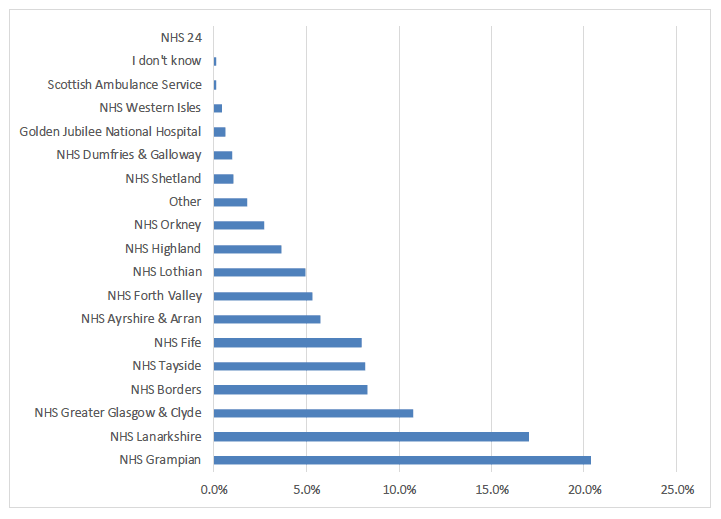
Figure description:
Professionals from 14 territorial health boards responded to the survey (table 8). Fewer responses were from the smaller boards. Highest numbers were from NHS Grampian, NHS Lanarkshire and NHS Greater Glasgow and Clyde.
Experience, overview, and access
Of the 1,131 who responded to the online survey, eight out of ten (81.1%) had previously consulted using Near Me (cf. 18.9% who had not).
When asked "Do you think video consulting should be offered for health and care appointments? (providing it is clinically appropriate)" over nine out of ten (94%) responded 'yes', four percent were 'unsure', and two percent thought it should not be offered.
Preferences
In common with the public survey, health care professionals were also asked to consider their preferences around three types of appointments: face to face, telephone and video consultation.
During Covid-19, there was no difference between video and telephone both being supported by 95% of respondents (cf. public =81% for phone and 84% for video) and just over half (56%) stating they would be comfortable offering face to face (cf. public =46%)
Once physical distancing is over preference for face to face markedly increased reaching (97.5% cf. public =90%) with use of video (88% cf. public =75%) and telephone (86%) reducing slightly cf. public =69%).
Health care professionals selected a range of consultation types that that they might use video for. The most common were 'advice and support' (88%), 'active management and/ or ongoing treatment' (73%) and 'review of long-term condition management including 'medication' (66%). Least preferred were 'acute presentations' (33%) and 'assessment before a procedure/ operation / hands on care' (31%).
In comparison three out of four who responded (74.8%) identified types of consultations where they would have concerns around using Near Me;13.2% had no concerns and 12% were unsure.
Related to these questions over 1,100 responses were provided to the main clinical scenarios where video consultations have been used or would be considered for use. Similarly, a list of over 800 scenarios were highlighted where clinicians responded that they would not wish to use video. These free text comments will be subject to future analysis.
Benefits and barriers
Average scores are calculated and go from 1 (strongly disagree) to 5 (strongly agree).
From the perspective of health care professionals, scoring of potential benefits ranged from 4.2 to 2.8 (Figure 20). The top three benefits scored were lower infection risk (4.2) (cf. public =4.2), improved access to services (3.9) (cf. public =4.1) and help to deliver a service that their patient had requested (3.7).
Near Me was thought to be less beneficial in terms of convenience for the clinician (2.9) nor to help to reduce recruitment challenges through remote working (2.8).
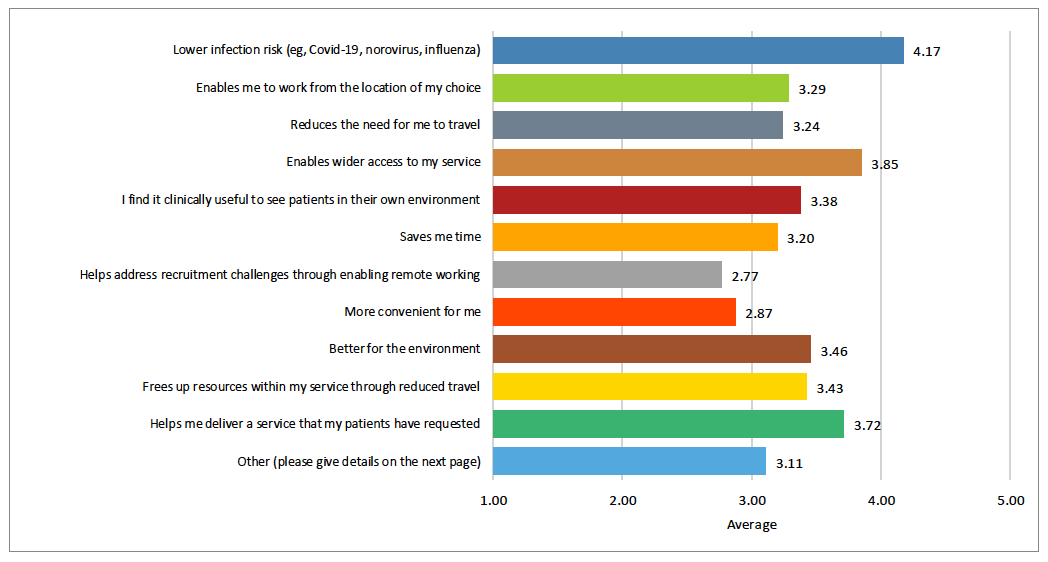
Figure description:
In their responses about possible benefits for their patients, clinicians scored (scale of 1 to 5, where 5 is most beneficial): the use of Near Me to be more beneficial in the following order Lower infection risk (4.4) (cf. public =4.2), reduces the need to travel (4.2) (cf. public =3.9) , save time (4.0) (cf. public =4.0) and take time of work (4.0) (cf. public =3.6).
Notably, in their responses about possible benefits for their patients, clinicians scored the use of Near Me to be more beneficial ranging from 4.4 to 3.0 in the following order: Lower infection risk (4.4) (cf. public =4.2) , reduces the need to travel (4.2) (cf. public =3.9) , save time (4.0) (cf. public =4.0) and take time of work (4.0) (cf. public =3.6). Five other benefits scored 3.8 or above (Figure). Clinicians thought that using Near Me as a means for being 'better for the environment' or reducing stigma were less important for their patients (Figure 21).
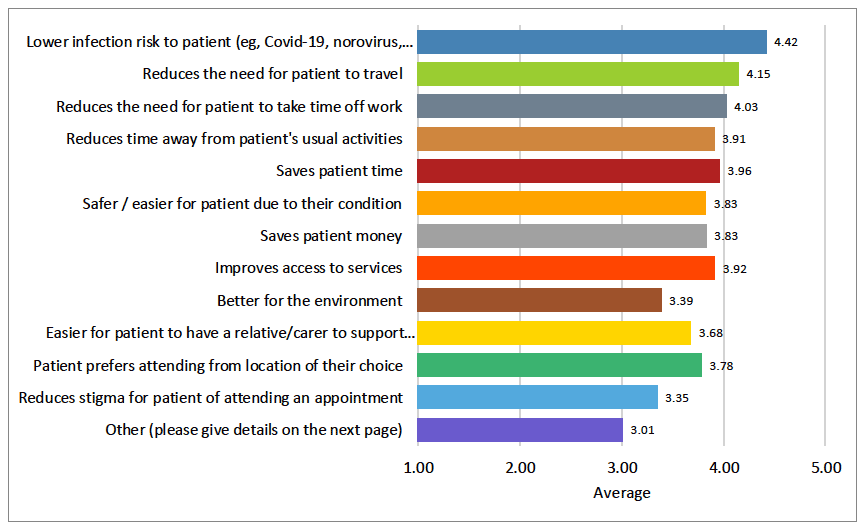
Figure description:
In their responses about possible benefits for their patients, clinicians scored (scale of 1 to 5, where 5 is most beneficial) the use of Near Me to be more beneficial in the following order: Lower infection risk (4.4) (cf. public =4.2) , reduces the need to travel (4.2) (cf. public =3.9), saves time (4.0) (cf. public =4.0) and take time of work (4.0) (cf. public =3.6).
From the list of potential disadvantages of video consulting, the health care professionals were asked to rate their significance to them. Scores were generally lower (4.0 to 1.9). Risk of poor quality; sound or image (4.0), 'worried about missing something on the video' (3.7) and preferring to seeing patients in person (3.7) considered to be the biggest barriers. For some professionals they found video calls stressful (2.1) or not confident using video calls for consultations (Figure 22).
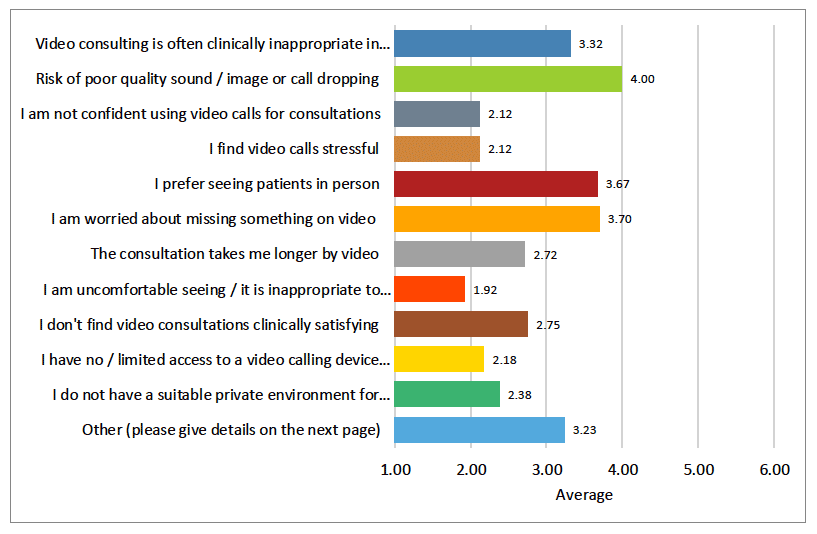
Figure description:
From the list of potential barriers of video consulting, the health care professionals were asked to rate their significance to them scale of 1 to 5, where 5 is biggest barrier: Risk of poor quality; sound or image (4.0), ‘worried about missing something on the video’ (3.7) and preferring to seeing patients in person (3.7).
Professionals views on likely disadvantages to patients
From the list of potential disadvantages health care professionals were also asked to rate their significance to their patients with scores ranging from 2.7 to 4.2. They considered the top three disadvantages to be: risk of poor quality of call (4.2), patients having no access to a device (4.0) followed by patients needing support (3.9). That consultations might take longer by video was thought to be less of a concern for their patients (2.7) and indeed scored similarly for impact on professionals (2.7).
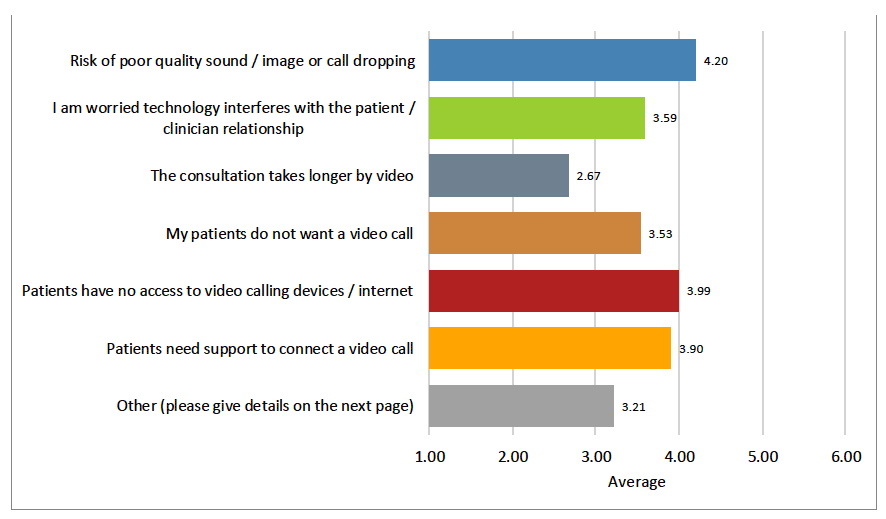
Figure description:
Professionals views on likely disadvantages to patients were scored (scale of 1 to 5, where 5 is the biggest potential disadvantage). The top three disadvantages were: risk of poor quality of call (4.2), patients having no access to a device (4.0) followed by patients needing support (3.9).
What would make it more likely for a health care professional to use video consulting in future?
There was a range of responses with those that scored highest being interventions to improve digital access to make it easier for all patients to use digital (4.3), if patients request an appointment by video (4.2) and an ability to provide mixed clinics combining video with face to face consultations, instead of all video (4.13) (Figure 24).
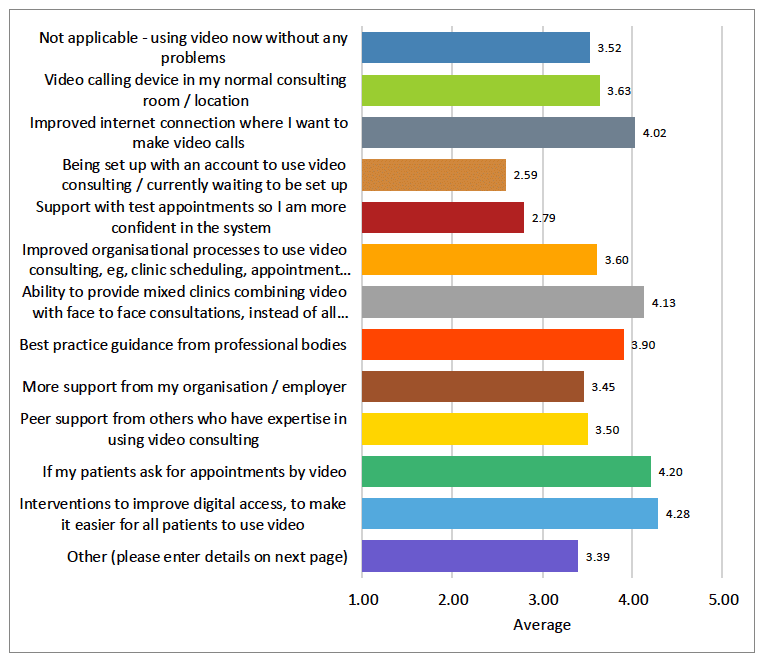
Figure description:
There was a range of responses with those that scored the highest being: interventions to improve digital access to make it easier for all patients to use digital (4.3), if patients request an appointment by video (4.2) and an ability to provide mixed clinics combining video with face to face consultations, instead of all video (4.1).
When looking at responses in terms of professionals strongly agreeing / agreeing around different features, it changed the emphasis slightly for some of the features (Table 9).
Table 9 The percentage of professionals agreeing around which features would make it more likely for them to use video consultations
(Feature that might make use of video consultations more likely : Percent)
Interventions to improve digital access, to make it easier for all patients to use video: 86%
If my patients' ask for appointments by video: 86%
Ability to provide mixed clinics combining video with face to face consultations, instead of all video: 79%
Improved internet connection where I want to make video calls: 72%
Best practice guidance from professional bodies: 71%
Improved organisational processes to use video consulting, eg, clinic scheduling, appointment booking: 60%
Video calling device in my normal consulting room / location: 59%
Peer support from others who have expertise in using video consulting: 55%
More support from my organisation / employer: 50%
Support with test appointments so I am more confident in the system: 28%
Being set up with an account to use video consulting / currently waiting to be set up: 19%
Perhaps surprisingly, just over half (55%) thought peer support from others with expertise would make it more likely that they would use video consultations. Patients asking for an appointment was more likely to influence a health care professional to offer Near Me appointments than best practice guidance from professional bodies.
Current and future functionality of Near Me
Health care professional were asked their opinion on what existing or possible future functionality might they use on a call. Most functions were used to a greater or lesser extent but one in five were not aware the various functions existed (Figure 25). Having an ability to send patient written information to download during a call was strongly supported (84%) with an ability to capture screen only favoured by one in three (Figure 26).
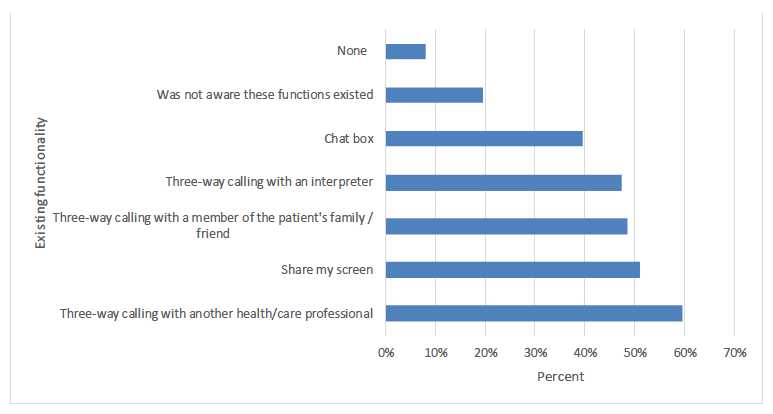
Figure description:
Health care professional were asked their opinion on what existing functionality might they use on a call. Most functions were used to a greater or lesser extent but one in five were not aware the various functions existed.
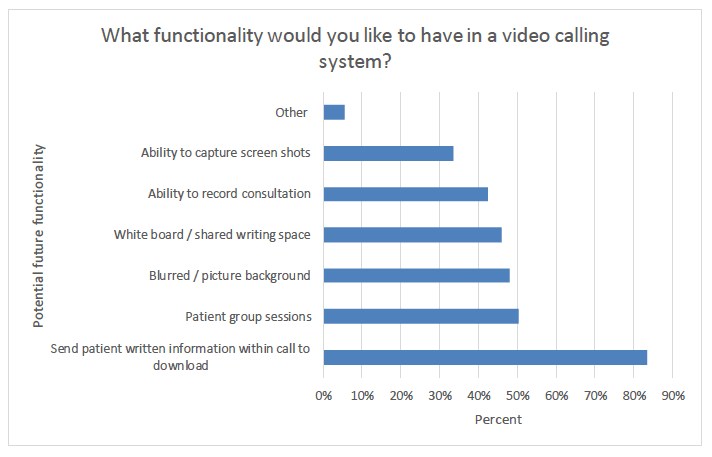
Figure description:
Having an ability to send patient written information to download during a call was strongly supported (84%) with an ability to capture screen only favoured by one in three (Figure 26).
4.2 Other feedback
4.2.1 Individual clinicians
Individual clinicians[14] submitted views to the generic near me email address (N=14, Table 10). These were all responded to and prompted some ongoing dialogue including welcoming that public engagement was taking place.
Some described early challenges to get video consultations embedded: "the patients love it, and the clinicians avoid change and make every excuse under the sun as to why it won't work."
Views tended to reflect the wider feedback with most clinicians generally expressing both benefits and barriers, though one described an entirely negative experience. The type of patients mentioned that video consultation could be used for included return patients, those with chronic conditions and to reduce travel. Several commented that "face to face will always be preferable for new patients." Four of the responses related to sexual health service, mental health services including clinical psychology, and psychiatrist. These responses were much more nuanced and reflected some of the complexities.
There were suggestions around improvements to functionality and some frustrations expressed with compatibility, technology, and infrastructure as significant barriers. One secondary care clinician commented: "My stress levels rise when the computers are so slow/keep crashing I can't do my job properly. Crashes mean the information I have just typed in gets lost. This generates clinical risk."
On the effect of staff switching to video rather than face to face consultations one respondent posed some questions: Is it more stressful? Is it more time-consuming? Is NHS Scotland planning any research on the impact of switching? The same clinician raised the issue of whether video consultations might have an impact on a clinician's mental health (whether they are aware of this impact or not).
In the opinion of another consultant "The biggest barriers are clinician's unfamiliarity and patient access to appropriate technology. Community hospital near me hubs as undertaken in Highland, could be a solution for patients who don't have / can't cope with the technology." As described by other responders and commentators the hubs would also serve to mitigate against wider issues such as privacy and wellbeing.
One of the Child and Adolescent Mental Health Services clinicians explained "Patients do not always have a quiet private space to have their consultation and in work with young people and families this leads to a number of boundary issues , confidentiality problems and at its most extreme child protection concerns. I have been told by young people after the event that they felt unable to talk because of the presence of other members of the household in the vicinity."
Overall, in terms of the use of Near Me, from a national perspective, it highlights some of the specific considerations around particular patient groups and different scenarios and settings. Naturally, it is to be expected that there will be different experiences of using Near Me (or not) for a broad spectrum of reasons which go beyond the scope of this public engagement exercise.
However, as the National Carers organisation pointed in their response the importance of "health practitioners being confident in using the 'Near Me' system and to have a positive attitude about the benefits of it If health professionals are not keen on using the 'Near Me' platform, it can lead to a poorer experience for the patient/carer."
Table 10 Summary of individual clinicians who responded, by the service they provide
(Ref / Service / Selected comments)
1 Adult Psychological Therapies Service
"I am very familiar with the Near Me video consultation system as a clinician in mental health services and I wanted to offer some additional feedback, from a staff side perspective. I think it is great that this survey is being done."
2 CAMHS[15]
"I am a CAMHS clinician offering, in normal times, individual and family-based appointments for a range of mental health problems. Near me has been a useful way of keeping in touch and continuing a level of mental health work with patients. It does have significant number of challenges for this type of work and some would of course apply more widely."
3 Clinical Psychologist
"There is already a huge amount of evidence showing telepsychology is equivalent to in-person, but most clinicians are unaware of this, and as a result, it is often treated as the poor cousin."
4 Diabetes
"I have been using it quite a lot in my clinical practice. Connectivity is an issue in several rural locations."
5 Dietician
"I have had some experience in using the system with patients and would make one point which for me is most important: the availability of a Near Me App" - See Table
6 GP
"I have used Near Me in clinical practice as a GP and it has been easy to use."
7 Infant feeding
"As an Infant feeding advisor, I wondered how I would be able to offer women support for feeding using this platform? Now four months on my doubts and apprehensions have been blown away."
8 Neurology
"I have used near me a lot and found that patients in general cope well. The question is where it fits into routine practice once we return to normal? How we use it in a pandemic and recovery will necessarily be different."
9 Learning disabilities
"It's important we help shape accessibility of healthcare digital platforms."
10 Physiotherapy
"It was quite a challenge to recruit colleagues to use Near Me prior to Covid-19 but folks couldn't get on board quick enough at the end of March 2020."
11 Psychiatrist/ Psychotherapy
"In the clinical world, you will easily imagine that we are all on that 'steep learning curve' both with the technology and in attempting to understand the effects of delivering our therapy over a new medium."
12 Research physiotherapist
"Working as lone practitioners may be a new experience for some and thus, the isolation is emotionally taxing but even those who work alone, they will have had colleagues in the department/clinic with which they could have had a chat to and importantly 'decompress' with".
13 Sexual & Reproductive Health
"As a clinician I would like you to know that the NHS internet infrastructure cannot cope with the load generated by video calls."
14 Sexual Trauma Service and CAMHS
"With traumatised patients and those who have been filmed for abusive purposes Near Me has had its limitations. I have used the phone successfully with some teenagers who have told me they do not like being so visible. The phone has been a good alternative with some of my patients."
4.2.2 Professional Bodies
4.2.2.1 British Medical Association (email 7 August 2020)
"Because many of our members have no experience of using Near Me, it is difficult to give a detailed views of doctors' experience in using it. However, it is very clear that in many parts of the NHS, especially in some secondary care environments, that IT provision, or the lack of it or poor quality of it, would make widespread use of video consultation difficult to deliver unless there is major investment in both hardware and software, but also improvements in the bandwidth of hardwired networks and Wi-Fi.
Additionally, many doctors have concerns about the ability of some patients, particularly those with cognitive impairment, learning difficulties or sensory impairment, to access these types of consultations and there's therefore a real risk of excluding a proportion of patients, and those who potentially are more vulnerable and in need of access to healthcare. A widespread rollout of Near Me would have to address these concerns.
Finally, the experience our members do have of Near Me is that it is potentially more time consuming than face to face consultation, and increasing the proportion of consultations done by such methodology firstly risks reducing the time available for other clinical activity, but also has implications for the capacity of healthcare systems in both primary and secondary care. It can therefore only be one potential option, subject to addressing the resource implications outlined above."
4.2.2.2 General Dental Council (e-letter 7 August 2020)
"Remote services, including those for healthcare and dentistry, are increasing in prevalence and can provide significant benefits for patients, particularly in terms of access and affordability. The move to remote provision of healthcare has gained more momentum and urgency because of the current pandemic, which has forced society to rethink traditional patient / professional interactions.
In dentistry, we are aware that providers are increasingly making use of remote platforms to facilitate and maintain patient access to dental services. The GDC is alive to the significant benefits that remote access can potentially bring to patients and is keen to see innovation develop in this area, where it can be done safely. However, as with any innovation in dentistry, the GDC needs to satisfy itself that patients are protected and that our registrants can apply the standards for the dental team to this emerging context of dental practice.
The standards for the dental team provide a framework within which dental professionals use their professional judgement and make decisions based on what is in the patient's best interest. Among other things, this includes safe and effective treatment planning and valid consent for such treatment. In many cases, physical and tactile assessments of the patient's head, neck and dentition will be necessary to inform clinical judgements that support a prescribed course of treatment and to address any underlying oral health problems. As such, face-to-face interactions remain an essential aspect of many dental interventions though that may vary depending on the stage of the intervention: screening, diagnosis, or treatment.
The GDC has made a commitment to continue to gather evidence about the potential risks and benefits of the remote provision of various forms of dental care. We await with interest the outcome of the Scottish Government's clinician survey and public engagement exercise regarding the Near Me video consulting service, and would welcome conversations about your findings, in particular how they may affect services delivered in Scotland and any implications for how we balance the benefits to patient access against the risks to patient safety.
4.2.2.3 Health and Care Professions Council (email 28 July 2020)
"From the HCPC's perspective, we are supportive of our registrants providing services using video consulting provided this is done in a way which meets our standards. During COVID-19, we've recognised it's really important that registrants take advantage of technology in this way where possible to manage the risks of infection to themselves, their patients and colleagues and have encouraged registrants to offer remote appointments where possible. However, we recognise this won't be possible for all care and treatment our registrants provide."
Relevant guidance[16]
Registrants practising during COVID-19 including adapting practice on providing services remotely.
Good practice in remote consultations and prescribing
4.2.2.4 Royal College of General Practice (RCGP)
RCGP confirmed they had completed the survey. RCGP also endorsed the recent update of the primary care guidance.
4.2.2.5 Royal College of Occupational Therapists (email 30 July 2020)
Their professional Adviser confirmed that survey had been completed on behalf of their members who had provided feedback.
4.2.2.6 Royal Pharmaceutical Society and Community Pharmacy Scotland
Guidance on the use of Near Me video consultations in pharmacy settings was endorsed by Royal Pharmaceutical Society and Community Pharmacy Scotland.
4.3 Other Organisations
Submissions from other organisations which included feedback about use of Near me from perspective of professionals and organisations is summarised below:
4.3.1 Hospices in Scotland
Service benefits
- Using technology staff were able to work more efficiently e.g. significant savings on travel expenses, time, and resources to attend meetings and similar. This also benefits staff as limits number of long days/journeys
- Less travelling time has allowed interaction with more patients and families in the community.
- Referrals to be taken from wider geographical area
Challenges with remote working:
- Most staff are hands on tactile health care professionals and have found this method of working challenging both professionally and individually.
- Home conditions and family arrangements have impacts on emotional and mental health wellbeing and it can be difficult to separate work and home. This can counterbalance the benefits if not managed effectively.
- Impact on MDT working because of social distancing and the ability to have groups of people together. Staff are missing face to face contact,
- Medical staff have had fewer face to face discussions with family members of hospice patients
4.3.2 Marie Curie Scotland
Accessibility
Video consultations was more frequently used to facilitate discussions between patients and family members unable to visit about their care. The feedback was positive.
Maintaining visibility of a patient's condition
The benefit of being able to physically see a patient through video rather than speaking to them by telephone to get a more complete picture of health and state of condition, including mental health, as well as to continue providing person-centred care.
Lack of touch
Staff mentioned the lack of touch of not being in direct contact with patients, as this is an important part of what they do. In a large proportion of cases, where patients preferred telephone appointments, it meant hospice teams unavoidably missed non-verbal cues that would normally be visible in face-to-face contact and influence individual palliative and end of life care provision.
Environmental factors
These were mentioned in focus groups in relation to space for hospice teams to have a video consultation in, especially in shared offices, and lack of equipment to do this.
Practitioners found it challenging as they were unable to see the rest of the house to get a complete picture of how the patient was doing. Many of our Marie Curie nurses providing palliative and end of life care in the community mentioned the 'doorstep conversation' that they often have at the end of a visit where they can speak privately to the family/carer. Distancing and hygiene measures meant the level of interaction with family/carers had to be reduced.
Types of consultations
Marie Curie community nurses and hospice teams wanted to ensure a relationship had been established with new outpatients at initial assessments to ensure they were comfortable of using video. Therefore, first appointments were conducted face-to-face. After the first meeting with patients, our teams felt more comfortable doing follow-up contact via video which highlighted the distinction between a new relationship and an established one.
Some of hospice teams felt that bereavement support should be provided face-to-face to be as informal as possible and connect with families/carers who were grieving (video consultation felt more formal).
4.3.3 Parkinson's UK Scotland
- All Parkinson's nurses and consultants are using phone/near me with face to face limited for urgent or new patients
- Nurses were covering consultant clinics in the initial lockdown phase
- Clinic numbers significantly restricted due to cleaning, social distancing etc
- Increase in mental health issues-carers and patients and mobility issues (many people not leaving their house)
4.3.4 Renfrewshire Health & Social Care Partnership
GP colleagues are generally happy using Near Me/Attend Anywhere for most types of consultation and have indicated they would make more use of it if they had access to more cameras in the surgery.
One practice for example commented they have up to eight clinicians (GPs, Nurse Practitioners and Advance Nurse Practitioners) who have been using it, but only two cameras. Noted if they had one per room would look to book regular appointment slots which would mean they could have reception staff sending links out and talking people through how to log on instead of currently moving to Near Me/Attend Anywhere during phone consultation. This quite frequently leads to a breakdown of technology at patient end and involves far more time to fix the problem or to cancel the video and make other arrangements.
On types of consultation practices might use Near Me video for - Acute Presentations, Active management and/or treatment of an ongoing condition, review of long-term condition management (including medication) and to provide advice and support.
On describing the main clinical scenarios for using video consulting comments include:
- To see a patient who is describing feeling breathless
- To better assess a child and determine if face to face appointment required
- For discussion involving patient and relatives in same or different locations
- To assess patients with joint pain.
4.4 Research
4.4.1 University of the Highlands and Islands (UHI)
Several colleagues from the UHI, including clinicians who provide services and conduct research provided a brief overview of various, issues, uses and comments on the vision, public engagement, equalities, and next steps.
They described that connectivity is an issue in several rural locations and that external routers are being used to overcome the problem. A project is also underway in UHI with the European Space Agency through an Innovate UK funded project linked to the University of Falmouth. This will use satellite to aid Near Me access for home-based VC.
Some Highland students are using this technology in their practice learning experience by participating in virtual placements due to their own health conditions. Postgraduate students will be using Near Me for some modules. This was a pragmatic solution to enable students to complete their clinical assessment due to Covid-19. The reason that a UHI platform was not used is that their exams were taken at the student's own place of work. NHS firewalls can block WebEx etc and thus they elected to use Near Me to overcome this issue.
From a quality improvement perspective, there was support for the vision to be embedded around safety, person-centred and sustainable care but commented:
"I do wonder if it would have also been worthy to have effectiveness in here. The evidence is limited but emerging and is likely needed to help shift the mindsets of those not yet convinced in terms of measuring patient outcomes i.e. can patients be discharged as quickly from specialist services when all appointment are via video? Are there hard outcomes that can be measured in terms of mortality, hospital admissions, A&E visits etc? Of course, I would always advocate that the patients' experience should also be considered/evaluated etc.
"In terms of process the public engagement work is super. I would be interested to hear how public feedback will be used to adapt/tailor how Near Me continues to be used / implemented. How will the SG demonstrate that they have not only listened to the public, but rather acted on the feedback from consultation? There are also the usual challenges about including the "easy to miss" groups - will creating VC consultation as the norm further accentuate the gap between those from different socioeconomic groups?
4.4.2 Other
Various clinicians who submitted views by email also described their own audit and research work including a clinical associate in psychologist who had carried out informal feedback on the use of video versus telephone (survey included), and another, a consultant who pointed out: "there is already a huge amount of evidence showing telepsychology is equivalent to in person, but most clinicians are unaware of this, and as a result, it is often treated as the poor cousin."
This clinician had been using video consultations for over twenty years. They added that they had "conducted quite a lot of research on this field (particularly in terms of psychology consultations) and would like to contribute in any way that I can."
Contact
Email: NSS.TEC@nhs.net
There is a problem
Thanks for your feedback